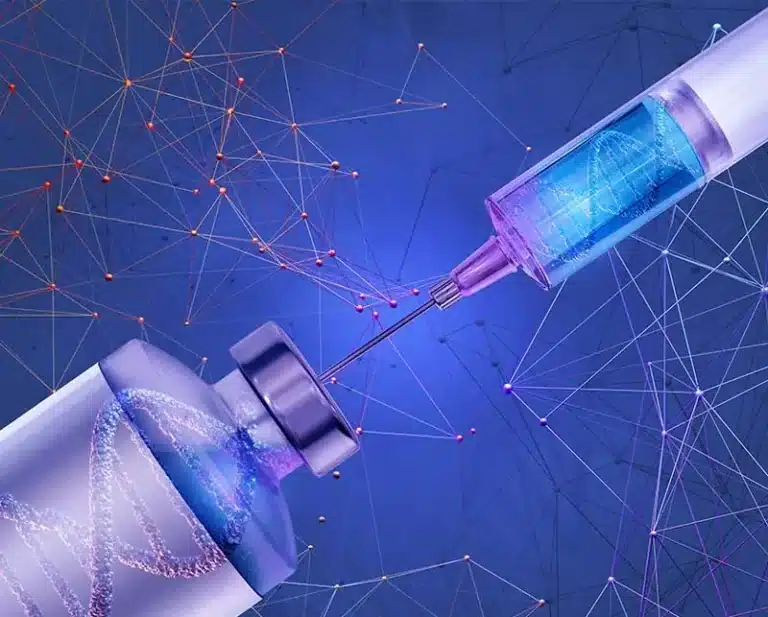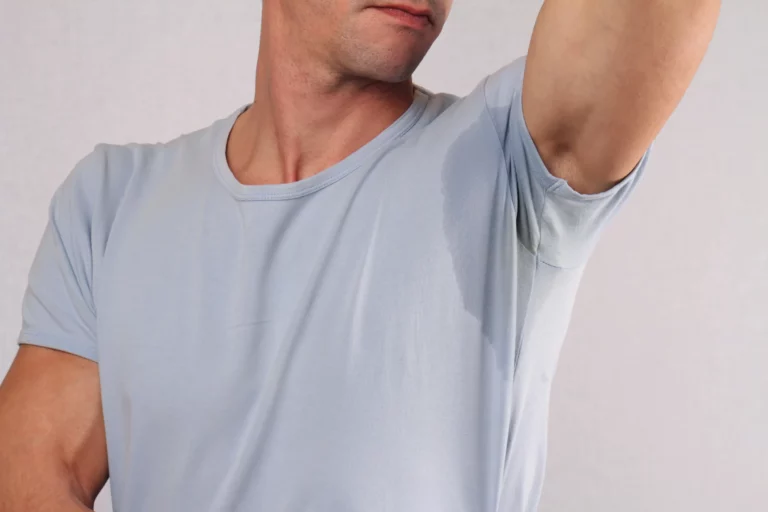Home » Conditions » Body » Excessive sweating
Hyperhidrosis, or excessive sweating, is an excessive production of sweat by the sweat glands. This condition often has a socio-professional impact.
About 5% of the population is affected. Hyperhidrosis can be generalized or localized to certain areas of the body, particularly the hands, armpits and feet. In this case, it is often bilateral.
In cases of excessive sweating, or hyperhidrosis, sweat production is abnormally high. Axillary hyperhidrosis is common, but various parts of the body can be affected such as the hands, feet and face.
The symptoms are clammy hands, persistent sweating on the forehead and sweat marks on clothing, particularly under the armpits.
People suffering from primary axillary hyperhidrosis can resort to botulinum toxin injections, which are an effective and safe treatment to reduce the symptoms of excessive sweating. The quality of life of affected individuals is improved.
Dr. Romano is a member of the International Hyperhidrosis Society and performs the treatment of primary axillary hyperhidrosis in Geneva.
These symptoms vary in intensity and may be more or less bothersome depending on the patient.

Sweating is a physiological mechanism necessary for maintaining body temperature. We have around 3 million sweat glands.
Excessive sweating often begins at puberty and can have several causes.
The factors that promote hyperhidrosis, especially a sweating “episode”, are : stress, anxiety, emotional sensitivity, stimulants (tea, coffee, taurine).
The treatments for hyperhidrosis are :
Treating excessive sweating improves patients’ physical well-being, emotional health and social life.
In fact, hypersweating can lead to considerable physical discomfort due to constantly wet clothing and frequent skin irritations.
Hyperhidrosis has a significant impact on social and emotional quality of life. Affected individuals may develop social phobia, avoiding interactions and public situations for fear of sweating “episodes”. This can lead to decreased self-confidence, social isolation and deterioration of mental health.

The principle of botulinum toxin injections is to block the nerve stimulation that reaches the sweat glands.
Dr. Romano is a member of the International Hyperhidrosis Society and follows the recommendations of the Swiss scientific societies, a summary of which is available in the Revue Médicale Suisse.
This injection is indicated for primary excessive sweating in the armpits.
Botulinum toxin treatment, although generally safe and effective for reducing excessive sweating, has certain contraindications to consider. This treatment is not recommended in the following cases :

The treatment of hyperhidrosis with botulinum toxin is recommended in several situations in cases of primary axillary hyperhidrosis.
The treatment of hyperhidrosis with botulinum toxin injections is a simple and quick procedure performed in a medical office. The duration of the injections is about one minute.
Initial consultation
During the first visit, Dr. Romano analyzes the severity of the hyperhidrosis and discusses with the patient to ensure there are no contraindications and to assess the relevance of botulinum toxin injections.
Preparation of the area
The armpits are disinfected, and a topical anesthetic or ice may be applied.
Marking
Dr. Romano marks the injection points for a uniform distribution of the botulinum toxin. These points are generally spaced 1 to 2 centimeters apart.
Injection
Dr. Romano injects small amounts of botulinum toxin just under the skin at each marked point. The needle used is very thin.
Number of vials of botulinum toxin
Two to three vials of botulinum toxin are needed to treat both armpits.
Post-treatment
No recovery time is needed; patients can resume their activities immediately after the session.
Botulinum toxin injections for sweating can cause some discomfort, but the pain is generally mild. The procedure involves multiple small superficial injections. To reduce discomfort, a topical anesthetic or an ice pack can be applied before the session. Most patients describe a tingling sensation or a slight burning feeling.
There is no pain after the injection.
Botulinum toxin injections are very effective for treating excessive sweating in the armpits. Botulinum toxin works by blocking the nerve signals that stimulate the sweat glands, therefore sweat production is reduced.
The effects generally begin to appear a few days after the treatment and last about 6 months.
To maintain the results, maintenance sessions are necessary once or twice a year.
The results of botulinum toxin injections for excessive sweating, or hyperhidrosis, are rapid.
The effects of botulinum toxin injections are noticeable a few days after the treatment, they are optimal one week after. The results generally last between 4 and 6 months.
The price of botulinum toxin for primary axillary excessive sweating depends mainly on the amount of product used.
The first vial is charged 500 CHF and each additional vial is charged 350 CHF. Depending on the intensity of the sweating and the area to be treated, one to four vials may be necessary. The total cost is therefore determined in a personalized way during the medical consultation.
Is botulinum toxin effective against excessive sweating ? The treatment of excessive sweating with botulinum toxin is known for its effectiveness and rapid results.

Unfortunately, there is no natural method to stop hyperhidrosis. However, certain habits can help improve daily comfort.
Hyperhidrosis, or excessive sweating, generally manifests as abundant, unpredictable sweating that is not linked to ambient temperature or physical activity. People who suffer from it may notice beads of sweat forming on their skin or constantly damp clothing, even in situations of rest or minimal stress. The most frequently affected areas are the armpits, palms of the hands, feet and face. If this excessive sweating interferes with your daily activities, causes social or emotional discomfort, or requires frequent clothing changes, you may be suffering from hyperhidrosis. A medical diagnosis is essential to assess the intensity of the symptoms and identify any underlying causes.
Consulting a doctor becomes necessary when excessive sweating significantly affects your quality of life or when unusual symptoms appear, such as localized excessive sweating, unexplained night sweats, unexplained weight loss, or sweating accompanied by chest pain, shortness of breath or fever. A doctor will be able to assess whether the sweating is a sign of an underlying medical condition, such as an infection, a hormonal disorder or another pathology.
What are the symptoms of excessive sweating ?
How does botulinum toxin act on excessive sweating ?
What is the best natural antiperspirant ?
Treating excessive sweating or hyperhidrosis : reviews
Can botulinum toxin for hyperhidrosis cause compensatory sweating on other parts of the body ?
What is the price of a botulinum toxin injection for excessive sweating ?
Treat excessive sweating : botulinum toxin before/after results
Is axillary botulinum toxin injection effective for treating excessive sweating ?
How to manage excessive sweating on a daily basis ?
What are the causes of excessive sweating ?
Which areas of the body can be treated for excessive sweating with botulinum toxin injections ?
What are the criteria to be a good candidate for botulinum toxin against excessive sweating ?
What are the possible side effects after a botulinum toxin injection for excessive sweating ?
How does a botulinum toxin injection session for excessive sweating take place ?
Are botulinum toxin injections for excessive sweating painful ?
What is hyperhidrosis ?
Sweating is primarily regulated by the hormone adrenaline (or epinephrine). Adrenaline is released in response to stress, excitement or "fight or flight" situations. This hormone stimulates the sweat glands, increasing perspiration.
Sweating profusely for no reason can be due to a number of factors.
In cases of hyperhidrosis, it is advisable to consult : a dermatologist or a general practitioner ; an endocrinologist if underlying hormonal disorders are suspected.
Hyperhidrosis can sometimes diminish or disappear over time, especially if it is linked to temporary factors such as stress or hormonal changes. However, for many people, hyperhidrosis is a chronic condition.
Deficiencies in certain nutrients can affect sweating.
Magnesium deficiency : magnesium plays a role in regulating body temperature, and a deficiency can cause excessive sweating.
B-vitamin deficiency : these vitamins are important for stress management and energy metabolism. A deficiency can increase sweating.
Hyperhidrosis is diagnosed by :
Certain pathologies can cause excessive sweating: hyperthyroidism, diabetes, infections, cancer, endocrine pathologies.
Homeopathic remedies such as Silicea, Calcarea carbonica and Natrum muriaticum can be beneficial.
Sage is a plant commonly used to reduce excessive perspiration.
There are several treatments for excessive sweating : antiperspirants, botulinum toxin injections (exclusively for primary axillary hyperhidrosis), iontophoresis, anticholinergic medications or surgery. The choice of treatment depends on the severity of the symptoms and the location of the hyperhidrosis.
Yes, some natural remedies can help reduce excessive sweating, such as using sage tea, apple cider vinegar or applying baking soda. A balanced diet and good hydration can also help reduce sweating.
Deodorants containing aluminum chloride are considered the most effective against hyperhidrosis. They temporarily block the activity of the sweat glands and thus reduce sweat production.
To manage excessive sweating on a daily basis, wear breathable clothing, apply effective antiperspirants, maintain good hygiene and avoid spicy or stimulating foods. In case of significant discomfort, consult a doctor for an appropriate treatment.
Excessive sweating can be due to primary hyperhidrosis (with no identifiable cause) or secondary hyperhidrosis (linked to a medical or hormonal condition or to certain medications).
Creams containing aluminum chloride hexahydrate are often recommended to treat mild to moderate hyperhidrosis. They reduce sweat production by temporarily blocking the sweat gland ducts. Consult a dermatologist to choose the most suitable product.
As we age, the sweat glands may become more active due to hormonal changes or certain medical conditions. The body may also find it more difficult to regulate its temperature.
Sweating causes loss of water, but not fat. To lose weight, it is necessary to burn calories through physical exercise and a balanced diet.
Anticholinergics, such as oxybutynin, are sometimes prescribed to reduce excessive sweating. They work by blocking the nerve signals that stimulate the sweat glands.
Sweat is the liquid produced by the sweat glands, while perspiration is the process by which the body releases sweat to regulate its temperature and eliminate certain toxins.
Sweating is regulated by the hypothalamus, a part of the brain that controls body temperature. It sends signals to the sweat glands to activate or reduce sweat production according to the body’s needs.
Spicy foods, foods rich in caffeine, or those containing alcohol can increase sweating by stimulating the nervous system and raising body temperature.
Drinking water helps regulate body temperature, but does not directly cause an increase in sweating. However, overconsumption of water in a hot climate can lead to increased sweating to cool the body.
Baking soda is considered an excellent natural antiperspirant. It absorbs moisture and neutralizes odors. Alum stone, a natural mineral, is also effective.